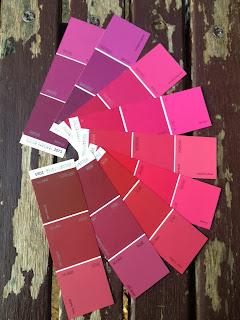I've been indulging my crafty side recently having fun working on some basic gum paste techniques. The color scheme for my sister's wedding next year is purple and white so I've been practicing various flowers and things for the corsage-type decorations for the cake - but more on that next year I'm sure..!
Since I've been doing taste tests with coverings for traditional British Christmas cakes I thought I'd have a go at something a bit more seasonal as well and went for the red Christmas 'flowers' Poinsettias - the red things are leaves, but more on that in a moment - and some holly.
I'm undecided whether I prefer a simple decoration of something like holly on a flat surface, just the traditional spiky snow scene with a ribbon and no gum paste decorations at all, or a very over the top and showy poinsettia decked out in ribbons. I'm slightly embarrassed by how fun it was trying them all out.
 |
| The traditional royal icing snow scene |
If you go to a Wilton shop you can get all kinds of handy tools and cutters to make leaf and petal shapes for various flowers and mats to imprint leaf textures etc. Poinsettias however appear to need to be made free-hand - unless you order a set from abroad. I relished the challenge, and had a go.
This is my first attempt, the leaves of which could probably be made a little finer and would benefit from some dark dusting powder to show the textures better. I assembled the red bracts in much the same way you would make a lily petal, folding the little flap over each wire, and then cutting them freehand with scissors.
Designing this reminded me how weird and amazing plants are. Earlier we covered the fact the red bits aren't actually flowers, but have you ever had a good look at the centre of one of these plants? There are crazy things going on in there! When poinsettias are depicted on fabric or in a drawing, there are often just a couple of yellow or gold circles in the center, but on the real plant there are actually intricate little flowers, or "cyathia" there in green, red and yellow. Though strange, my representation in sugar doesn't even do full justice to the wonderfully bizarre arrangement of the actual plant.
The spiny leaves of the holly were created using lily cutters and then a small round cutter to remove semicircles from around the edge. I put a dot of clear varnish on top of the berries so they would shine. Since these displays are for placing on cakes that are for eating, all the wires need to be wrapped in floral tape so that the metal doesn't touch the cake. Note that if you have a large display that you want to anchor into the cake, you should insert your wrapped stems into a plastic flower spike that you push into the cake.
There is, of course, an inherent strangeness to this kind of sugar craft. You go to all the trouble to make something delicate out of sugar, only to include wires and make it inedible.. It is a conundrum, but they are not completely redundant as aside from being quite impressive when made well, they don't wilt as would fresh flowers, and since they are made for special occasions, they can be kept indefinitely as a memento of the occasion if you're careful with them.
It is also possible to make simpler gum paste decorations that contain no wires and would be completely edible, albeit crunchy. You would need to mount them on a gum paste base to set them on the cake, or glue them directly to the cake with edible glue. Similarly, if you make simple decorations using fondant or marzipan, they would be completely edible too.
Oh and yes, all these decorations travelled with me to the UK too, carefully wrapped in tissue in a box in my hand luggage this time. No problems at security for these or the oh, 100 or so macaron shells packed along side them - "you do macarons don't you?" says my sister, the bride to be, "this 10-layer tower I've seen looks great!" (Next year I'll need to take more than 100 macarons..) The Christmas sugar decorations survived the journey quite well, with just a couple of the spiky tips falling casualty along the way.
































































